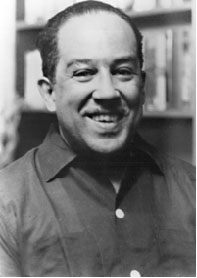About the Library

Hold fast to dreams
For if dreams die
Life is a broken-winged bird
That cannot fly.
Langston Hughes, '29
Langston Hughes was born in Joplin, Missouri, in 1902. His parents were divorced when he was a small child and his father moved to Mexico. He was raised by his grandmother until he was twelve, when he moved to Lincoln, Illinois, to live with his mother and her husband. It was during his high school years that Hughes began writing poetry. Following graduation, he spent a year in Mexico and a year at Columbia University and travelled to Africa and Europe. He moved to Harlem, New York, in November 1924. Hughes first book of poetry, The Weary Blues, was published by Alfred A. Knopf in 1926. He finished his college education at Lincoln University in Pennsylvania three years later.
Hughes, who claimed Paul Laurence Dunbar, Carl Sandburg, and Walt Whitman as his primary influences, is particularly known for his insightful, colorful portrayals of black life in America from the twenties through the sixties. He wrote novels, short stories and plays, as well as poetry, and is also known for his engagement with the world of jazz and the influence it had on his writing, as in "Montage of a Dream Deferred." His life and work were enormously important in shaping the artistic contributions of the Harlem Renaissance of the 1920s. Unlike other notable black poets of the period ( Claude McKay, Jean Toomer, and Countee Cullen) Hughes refused to differentiate between his personal experience and the common experience of black America. He wanted to tell the stories of his people without personalizing them, so the reader could step in and draw his own conclusions. Langston Hughes died in 1967.
“I have discovered in life that there are ways of getting almost anywhere you want to go, if you really want to go.”
– Langston Hughes, Class of 1929
Langston Hughes Memorial Library is named for one of Lincoln University’s most famous graduates, the celebrated poet Langston Hughes, who also bequeathed his personal library here upon his death in 1967. The library itself is an integral part of the Lincoln experience. The 1972 facility contains areas for microforms, periodicals, computer labs, reading lounges, individual and group study rooms, special collections and the University archives. Students are able to access the library for after hour study through a separate designated entrance. Phase I of a total library renovation was completed in 2008. Phase II of the renovation was completed in 2011.
Here you will find…
- A collection of more than 185,000 volumes
- Databases containing in excess of 30,000 journal titles
- Extensive materials representing all aspects of the black experience, including African-American and African materials
- Special events
